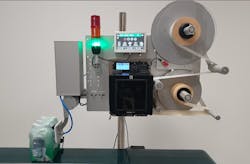Front Side Label Application with the Swing Arm Applicator
The electric swing- arm applicator has been designed as part of a print and apply system that allows for the label to be applied to the top, front, side or back of the product, even on moving products. This system is an optimal solution for front-of-product applications because the electric motors make it fast and safe during application.
Front Side Application
The most common use of front-side label application is in the beverage industry, to identify bulk or bundled water, soft drinks, wine or beer. To better understand why the front-side is the best location for the label in these instances, it is necessary to understand how the bundles of bottles or cans are created in the beverage industry.
The bottles are gathered in groups of six, twelve or more, and then enter the shrink-wrapping machine, where they are wrapped in a plastic film. A shrink wrap machine dispenses the film, which is loosely folded over the product and then the film is heated and forms a tight wrap around the products. This creates a secure grouping of the individual bottles for shipping and handling.
The bundles continue their journey along the production line; being transported horizontally. Often, the bundles are not completely covered by the shrink wrap on the sides, and for that reason, a side-application of the label is not an option. The top-side is usually not flat enough for a precise and stable application, leaving the ideal side the leading edge or front of the bundle because it is the longest and flattest side.
Apply Two Labels in Real Time
The swing arm applicator is also designed to apply labels on two adjacent sides of a product in real time. Thanks to its flexibility, the applicator can apply two labels on two adjacent sides, precisely on the top and front or on the front and side, as it can be mounted vertically or horizontally on the production line.
Why would a manufacturing company need to apply two labels in real time on the same product? Applying two labels increases the visibility of the information printed during the palletization process. In fact, during this phase, the various products are stacked one on top of the other, on different lines, consequently not all sides of these boxes are visible. By applying two labels on two different sides of the product, it increases the possibility that, once placed on the pallet, one of the two labels is always visible, facilitating the transmission of information.
How can you be sure the swing-arm applicator is the right solutions for you?
Contact Phoenix Labeling today and let us provide you with the information you need for your application and process.
Phoenix Labeling is the world leader in the designing and manufacturing of smart electric Print & Apply labeling systems. Our machines are installed on all five continents and operate 24/7 to identify secondary and tertiary packaging in a variety of industries.

